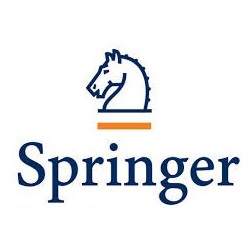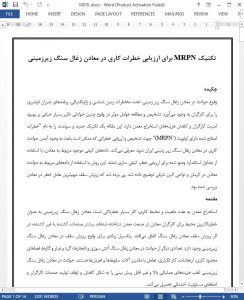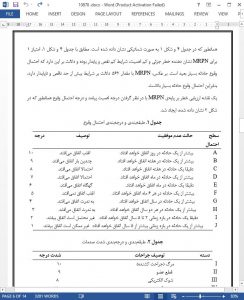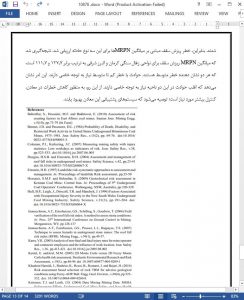ABSTRACT
Accidents in underground collieries, under geological and geotechnical uncertainties, cause some irrecoverable consequences for workers. Recognizing and studying the effective factors in the occurrence of such accidents have a very crucial impact on improving worker safety and reducing mining costs. This paper introduces a new and beneficial technique named “modified risk priority number (MRPN)” for recognizing and assessing those risks which may cause working accidents in Iranian underground collieries. The available qualitative data from the mines was quantified using standard tables established for risk assessment. The technique was exemplified using data from mine accidents in Kerman and East-Alborz regions. Roof-fall was found to be the most significant risk factor in the mines that were investigated.
INTRODUCTION
Mining is a particularly hazardous work because of its nature and the work environment (Shahriar and Bakhtavar 2009). Underground collieries are known as the most dangerous environment for mine workers in the mining industry. Most injuries, both fatal and nonfatal, occur due to roof-falls in collieries. There is a large potential for roof-fall occurrences in underground coal mines (Shahriar et al. 2009). Some other in collieries are fires and explosions, dust and gasses, confined working spaces, vibrations, repetitive work, interaction with machinery, and falls and slips. Accidents in underground collieries often impose unpredictable, high expenses on total operational costs in the form of production stoppage and reduction, workers’ injuries, and potential liability claims.
CONCLUSIONS
Modified risk priority number (MRPN) is introduced for risk assessment of working accidents in underground collieries. It can be properly applied in all such situations where a degree of safety should be determined. MRPN was assessed by applying data from accidents in Kerman and East Alborz underground collieries. The results showed that roof-fall was the only major risk in the Kerman collieries. In the East Alborz collieries, however, in addition to roof-fall, the risk of gas poisoning was considerable. Among all the incidents occurring in the regions, only “being struck by flying debris,” “being trapped between heavy objects,” and “destruction” were categorized as being related to roof-falls. Therefore, the risk for roof-fall was assessed based on the average MRPNs for three types of accidents. It was concluded that the average roof-fall MRPN for the Kerman and East Alborz coal regions equal 127.7 and 111.7, respectively, both indicating a medium risk. Accidents to which a “low to medium risk” category is ascribed require special attention. This indicates that most accidents in both regions require special attention. Hence, to reduce risks in the mines, control is needed most; it is recommended that the support systems of these mines be improved.











